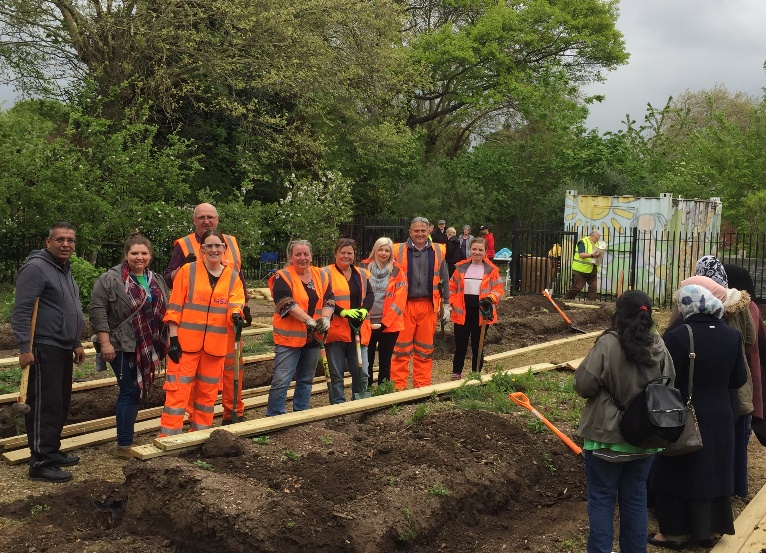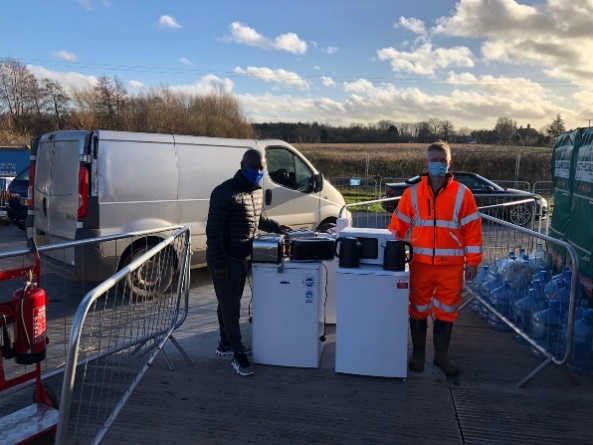Being a good sustainable neighbour
As the first teams on the ground, in 2017 early works contractors started legacy building against a backdrop of negative public sentiment, political pressure, unsupportive media publicity and protest activity. During those first three years, the project went through government reviews and various challenges, which made people constantly question whether the project was going ahead, or if it could be stopped altogether.
To break through these barriers, from day one the Enabling Works Contractor (EWC) on the northern section of High Speed Two (HS2) Phase One approached this challenge with a ‘can do’ attitude to being a good neighbour and tried to say ‘yes’ to community requests wherever possible. Volunteering and social value initiatives helped EWC to open doors that were previously closed by establishing positive, trusting relationships and generating goodwill towards the project within affected communities. These activities were developed and implemented in collaboration with subcontractors and wider project teams and serve as an example for future contractors to follow. This ultimately enabled EWC to minimise obstacles originating from stakeholders and communities when works started in earnest.
This paper will be of interest to contractors considering their approach to community engagement and social value strategy.
Background and industry context
The Enabling Works Contract (EWC) on the northern section of High Speed Two (HS2) Phase One (also known as Area North) is being delivered by the Laing O’Rourke Murphy (LM) joint venture.
LM’s Area North team saw opportunities in east Birmingham where old industrial units were earmarked for demolition to make way for the new rail corridor. As standard, before a building is demolished, numerous checks are undertaken to catalogue and assess materials and how these can be disposed of in a safe and responsible manner. HS2’s vision for no net loss inspired LM and its subcontractors to put emphasis on assessing how surplus site materials could be upcycled and reused for community benefit.
Other subcontractors from various rural sites along the route also contributed to these efforts and were able to ‘give back’ in various ways, including donating wood chip to community gardens and donating white goods and office materials from demobilised sites.
Approach
For EWC to be good a neighbour, it was important to ensure that all the whole team including the delivery teams and supply chain partners embraced this ethos and kept community legacy at the forefront of their minds so that opportunities could be identified. This was achieved through simple techniques.
- A series of workshops and toolbox talks. As part of Area North’s “go to work” project inductions, the community, environmental and project benefits of reusing surplus site materials were discussed at the outset with supply chain partners.
- Putting legacy and recycling on the agenda of various delivery team meetings and working closely with supply chain partners ensured that they alerted the relevant project manager and community engagement manager of any surplus materials identified on site. The community team could then approach local charities, social enterprises and community groups who could make use of them.
- Showcasing best practice at the quarterly supply chain forum, where all directors of the EWC subcontractors meet, gave supply chain partners a platform to be celebrated for their efforts and inspire others to join in. The community team used this forum to launch new initiatives and build support for those.
- Just ask. The simplest way to get buy-in is to just ask. Many suppliers are happy to provide plant, labour or materials to support good causes. Some of this would be covered in their contract. At other times, a goodwill gesture outside contractual obligations was looked for. Important factors to remember are proximity to site (the closer to their site the charitable organisation is, the more chances it would win support) and timing: ask early and often.
- What is in it for the supply chain? EWC offered quality photographs to supply chain partners, especially Tier 3 contractors who often do not have access to a professional photographer. Charitable giving efforts were also documented in case studies, which were shared with the supply chain so they could potentially use this for winning work in the future. Opportunities for incorporation into HS2 and LM internal publications, social media posts and business profiling (e.g. on the ‘On board with HS2’ webpage), and potentially external media are always welcomed by suppliers as it raises their profile. It is recommended that publicity and photography consent forms are signed at the start of any charitable project by contractors and charity contacts to avoid confusion at the time of project completion.
- Charities were helped that did not qualify for CEF/BLEF funding. The CEF/BLEF funding application process sometimes proved too difficult for smaller charities to navigate. LM was committed to helping charities which approached the project to ensure they received some benefit even if they did not meet the CEF/BLEF criteria.
- Suppliers were encouraged to use social enterprises. Several social enterprises have collected used plywood from site, and provided catering, cleaning or waste collection services. LM encouraged all supply chain partners to work with these organisations wherever possible.
Below are some examples of donations to communities.
LM and subcontractors UNITE to help homeless shelters

LM worked closely with Birmingham City Council (BCC) to identify and implement opportunities to re-use furniture from the former UNITE student accommodation buildings that were earmarked for demolition. LM and its supply chain saved hundreds of good quality furniture items from landfill by donating them to the BCC team, who were looking for items to furnish their homeless shelters. These donations saved BBC a substantial amount of money, resources and time. The student room furniture was moved into temporary storage by LM until BCC was able to use them in the two new homeless shelters they were building in Highgate and Aston.
Green space in East Birmingham for educating about sustainability

At Ward End Park in Washwood Heath, LM and its supply chain partners provided tools and materials to build new raised planting beds for the local community. LM staff from various teams donated their time to cut the wood to size, compile bed frames, and set them up in the garden. They were assisted by the Alum Rock Community Forum and Ward End Councillor Mohammed Aikhlaq. While they were putting together the garden beds, they got to spend time with these community leaders and better understand their needs, and how locals could benefit from HS2 – both as a source of regeneration and as a green corridor.
Corridor clearance donations

During the later phases of LM’s early works contract, LM donated wood chip to community groups and allotments, as well as logs, forest stools and 10 carved wooden animals to schools and community organisations close to the HS2 route. Communities knew LM was responsible for tree clearance and such clearance was generally viewed as negative. However, many understood that some positives could be won for local groups such as the donation of felled wood and wood chip. The donation of these material balanced conversations about clearance between LM and the public, and brought a human element to the project and the workers who were always most helpful and accommodating to deal with requests that came in. It also allowed LM to bring the Green Corridor creation into the conversation.
Donation of white goods

Discussions with supply chain partners during the project induction revealed that often when sites were demobilised, rather than paying for the storage and transport of white goods and other items, it was quicker to scrap existing items and buy new on arrival to the new site.
When suppliers Thomson Environmental were demobilising a works compound, they were keen to find such items a suitable home in the community. The area’s community engagement manager had previously engaged with a charity in Birmingham called “Start Again”, which supports homeless people through the rehousing process. For example, the charity purchases household items to furnish the homes they provide for those in need.
The white goods that were made available by Thomson were collected by the charity and donated to several newly housed residents. The donations enabled several new tenants to access their properties earlier than planned.
Outcomes and learning
Some big wins
- Through various donations, EWC hugely reduced the number of items being scrapped or sent to landfill during the project and brought wide-reaching benefits for local communities affected by HS2.
- Sections of the community were engaged that may otherwise have been hard to reach. In turn this increased their awareness of HS2 and the aims and values of the project and its contractors.
Some lessons learned
- There was a need to be vigilant when people approached the project for personal favours, such as the donation of wood chip for private gardens or driveways. LM’s experience from past projects has taught that this creates precedents that are hard to overcome or to justify. A submission form was developed to ensure that all requests were thoroughly detailed, to ensure that commitment was made only to giving materials to projects for public use. Toolbox talks were held with supply chain and construction teams to explain this approach.
- A significant amount of charity work was delivered and created a large legacy and could have sought external third-party recognition for work through awards.
- Logistics were as important as the donations themselves. Many charities did not have transport to collect donations from site. Delivery costs therefore fell to the contractor and in some cases large vehicles were not suitable for making deliveries. LM sometimes had to stagger multiple deliveries which was more costly for the suppliers and in some cases the cost was prohibitive.
- A further recommendation would be to ensure that any donations are clearly defined and understood by recipients before taking place. Where there is a limited amount of time and/or materials available, it is important to stress these limitations to potential recipients. For example, it can be stressed that obtaining donated items is on a first-come first-served basis. Some charity groups depend on donations and positive relationships can turn sour if perimeters are not clearly defined and agreed early in the process.
Sometimes best intentions still went wrong
During the delivery of a large charitable donation, relationships between the stakehoder and the delivery team soured due to unclear communication at site level and the additional requests that were not approved or refused formally. This caused reputational damage.
The Area North team investigated the case and identified several learnings.
- Conversations and actions agreed during delivery site meetings with stakeholders need to be documented and captured formally.
- Formalising the onsite delivery process is recommended. When a stakeholder requests additional work/donations beyond those originally agreed, during delivery these need to be processed officially e.g. through a stage gate process.
- Always ensure that meetings and discussions are attended by more than one stakeholder representative and more than one contractor or supply chain representative to avoid ‘he said – she said’ situations.
- Manage expectations upfront and under promise, over deliver.
- No matter how much has been donated, if stakeholders feel the company has not delivered on a perceived promise they will object and may go public which could harm the project.
Recommendations
To overcome some of these issues, it is recommended that ideas on how materials may be reused are addressed early in the project when more resources and staff are available, rather than at the end of the project when sites are scaling down.
One of the first tasks undertaken as part of the engagement strategy development was to identify and map charities and community groups near the line of route. Then, in discussion with project teams and subcontractors, develop an understanding of what materials might become available in addition to the number of charitable giving days they could commit to.
Conclusion
Construction projects have access to a range of materials, plant and labour that have great value to charities and community groups affected by HS2. However, it is important to clearly define what is being offered from the outset to avoid complications and accusations of broken promises further down the line.
The outcomes of EWC’s approach have enabled the HS2 project to leave a wide lasting legacy in numerous communities located along the line of the route. It has enabled LM to develop positive relationships and become part of the communities in which the company works. It has also been a good opportunity to highlight to communities that seeking to mitigate the impact of works is a key project priority.
The learning legacy is that the role of engagement and building relationships with communities and striving for “best for project” is not just the role of one function, but the whole business, and everyone has a part to play, whether it be large or small.
There are many ways in which contractors can contribute towards affected communities beyond simply financial. Working with supply chain partners in the early stages of the project can pay dividends in social value later in the project. By hosting specific toolbox talks and ensuring that engagement and social value were discussed in readiness reviews and “go to work” meetings, subcontractors better understood the value of community relations and how their work and behaviour could have a positive impact. By conducting mapping exercises to understand communities contractors can use surplus site materials to the greatest effect to ensure a lasting legacy.
Acknowledgements
The Laing O’Rourke and Murphy team and supply chain for their ongoing support of the charitable efforts for which they contributed time, labour and plant generously and free of charge.

